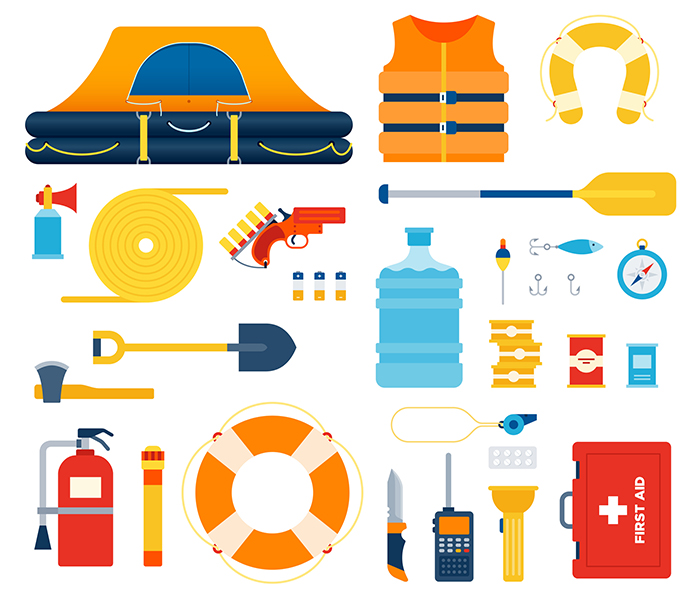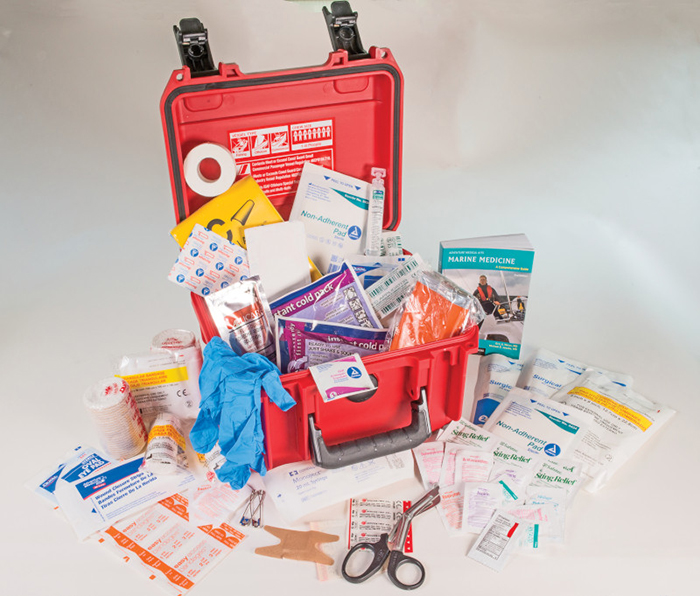Advertisement
Go beyond the obvious choices and prep your boat with this critical safety gear and spares for a safe, glitch-free season.

By law, recreational boaters are required to carry safety equipment, including life jackets, fire extinguishers, and visual distress signals, but the USCG minimum equipment requirements are just that – minimum requirements. By carrying additional tools, spares, and medical equipment, you can better respond to an onboard emergency, or prevent one from happening altogether. Some states may require or recommend items in addition to federal requirements, so be sure to check your state boating office website for details.
So, what equipment should you carry in addition to the required items? In assembling a kit, you’ll have to consider your vessel type, crew, and where you boat (e.g., a lake kayak can’t carry the same amount of gear as a bluewater sailboat). While there’s no one-size-fits-all safety boating kit, here are some items to consider, and there may be many more for your type of boating.

ACR ResQLink View 425Personal Locator Beacon
Communication devices
You should ideally have more than one way of calling for help.
- Cellphones can run out of batteries or be dropped in the water. Keep your cellphone in a waterproof and floating case, and bring a dedicated battery bank aboard for recharging. Download the BoatUS App for quick access to routine, nonemergency services, such as towing, battery jumps, fuel delivery, and soft ungroundings. Remember that many boating areas are beyond the coverage area of cellphones.
- VHF radios are inexpensive and invaluable for coordinating a rescue. Use a Digital Selective Calling (DSC) VHF radio, which has a one-button mayday feature and can send your position to rescuers.
- Two Way Satellite communicators, EPIRBs, and PLBs are good options, especially for areas out of cellphone and VHF range.
Navigation
Have a backup system for navigation (or several), especially if you don’t carry paper charts. It can be as simple as downloading navigation apps on your devices and computers, or, even better, buy a stand-alone waterproof handheld unit to keep on the boat. Paper charts, however, are also good to have aboard.
Secondary propulsion & ground tackle
Engine failure can lead to an emergency situation (e.g., drifting onto rocks). You should have other means of controlling the movement of the boat such as a secondary outboard or oars/paddles. Carry an anchor and line to keep your boat stationary while you wait for help.

Tools & spare parts
Assemble a dedicated toolkit and collection of spares for the boat and store them in a waterproof container to keep them dry and prevent rust. Check for rust periodically, and oil if needed. You may also want to keep a reference book aboard for troubleshooting. Following are examples of tools; you may need many more.
- Knife (e.g., cutting line from a fouled propeller or stripping electrical wire)
- Multi-tools if of good quality, can be very helpful and suffice for other tools.
- Spark plug wrench
- Adjustable wrench(es) sized up to the largest diameter fittings on your boat (e.g., stuffing box and thru-hull fittings)
- Socket set
- Multihead screwdriver. Ideally, carry both short- and long-shaft screwdrivers and screwdriver bits for the types of screws you have
- Needle nose pliers
- Bolt cutters (for cutting sailboat rigging in the event of a dismasting)
- Hammer for those times when nothing else seems to work
- Headlamp, flashlight, spotlight
- Binoculars
- Snorkel and mask to inspect under the boat if you are capable of safely doing so
Spares & consumables
- Kill switch
- Pull cord
- Spark plug
- Fuel and oil filters
- Extra fuel
- Electrical tape
- Duct tape
- Stainless steel high-quality hose clamps of varying sizes
- Zip ties
- Stainless steel wire
- Spare rope of various diameters and strength
- Batteries for onboard electric devices
Spare bilge pump
Every boat should carry a manual bilge pump in addition to their primary bilge pump, or at a minimum, a bucket for bailing water. You may additionally choose to carry underwater epoxy for emergency hull repairs, or a universal one-size-fits-all hull plug.

Medical supplies
Carrying a high-quality marine first-aid kit is a must. Also stock a supply of seasickness medication and rehydration salts. A marine first-aid handbook or app is a good addition.
Survival equipment
Rescue teams may take a while to reach you, particularly if weather conditions are poor. Be equipped to spend the day and night outdoors. Equipment may include:
- Tarp or heat reflective emergency blanket
- Spare water and food
- Sun protection
- Fire-making supplies
- Warm and dry clothing
Once you’ve assembled your kit, keep an inventory and review items annually – batteries can die, items may need to be replaced. Also, ensure that you and your crew are comfortable using everything in the kit. You can do this by practicing emergency drills (e.g., MOB recovery), attending boating safety seminars, and taking a first-aid course. And remember that these items are very basic. Your type of boating, crew, experience, and many other factors will probably call for much more.
A boating safety kit that exceeds the minimum requirements should not only keep you safer, but also provide you with greater peace of mind on the water. After all, who wants merely a passing grade when it comes to boat safety?
